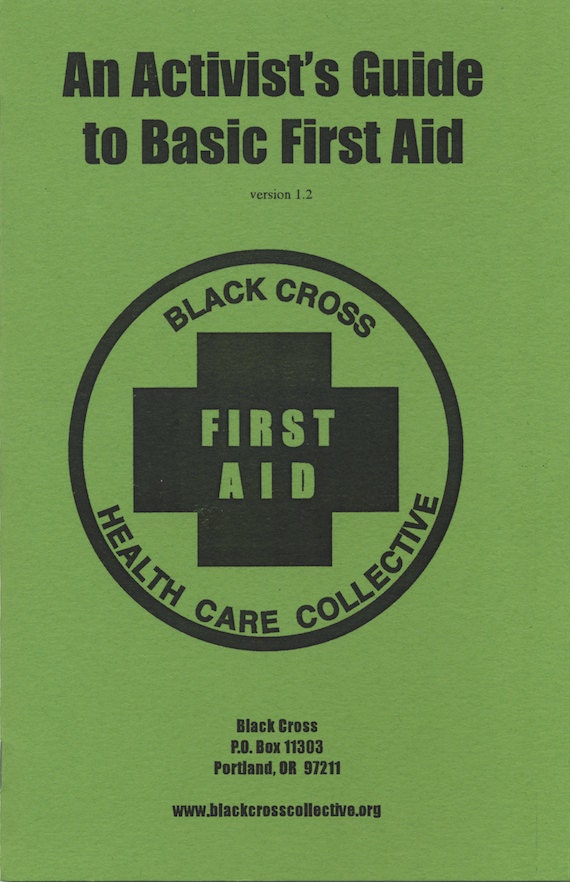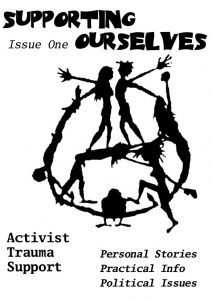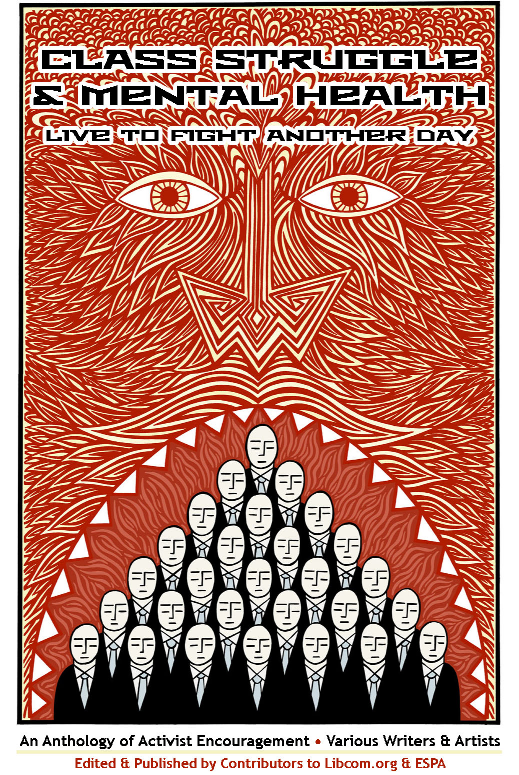 The American plantation relies on the mental distress of those it oppresses. As revolutionaries, we seek the liberation of people in bondage, both in prisons and psych wards. In order to eliminate patriarchy, capitalism, gender, and anti-blackness, we must address the significant psychological damage these forces inflict.
The American plantation relies on the mental distress of those it oppresses. As revolutionaries, we seek the liberation of people in bondage, both in prisons and psych wards. In order to eliminate patriarchy, capitalism, gender, and anti-blackness, we must address the significant psychological damage these forces inflict.
The trauma caused by social isolation, psychological manipulation and physical oppression is felt by all of those who are locked up, enslaved and otherwise targeted by the barbaric enforcers of white supremacy. The rampant psychological distress we are accustomed to is the effect of living in a depraved world. It is not possible to address “mental illness” without addressing the overwhelmingly reactionary nature of American society.
Psychological Emancipation for Revolutionary Abolition seeks to create ways of dealing with psychological distress which build up the revolutionary relationships that are needed to help people stay free. We must not only be supporting our fellow revolutionaries in their time of psychological need, but developing the patterns and practices of social cohesion that create strong bonds more capable of withstanding state repression, dealing with psychological distress, and undertaking militant action.
The skills, ideas and methods of organization proposed in this call for a revolutionary abolitionist approach to psychological emancipation will beuseful to anyone seeking to overcome the psychological barriers to securing their own liberation, but the ultimate goal of PERA is to destroy locked psychiatric treatment, prisons, and the state itself. This means that to truly succeed PERA requires support from and coordination with a broader abolitionist network, the Revolutionary Abolitionist Movement.
Read the PDF version

 Subtitled “A DIY Guide to Uncivilized Oral Hygiene” this zine is an exploration of dental care without relying on large corporations or even smaller and unnecessary “green” companies. There’s ideas for alternatives to use for toothpicks, general tooth care, herbs for cleaning teeth, etc.
Subtitled “A DIY Guide to Uncivilized Oral Hygiene” this zine is an exploration of dental care without relying on large corporations or even smaller and unnecessary “green” companies. There’s ideas for alternatives to use for toothpicks, general tooth care, herbs for cleaning teeth, etc. This zine provides a basic introduction to herbalism alongside a collection of home remedies for common health problems. The information is organized into broad categories based on body parts (head, abdomen, etc) and then from there conditions and symptoms. It’s easy to use and a good introduction to DIY healthcare. There is also a lengthy suggested resources section that recommends additional sources.
This zine provides a basic introduction to herbalism alongside a collection of home remedies for common health problems. The information is organized into broad categories based on body parts (head, abdomen, etc) and then from there conditions and symptoms. It’s easy to use and a good introduction to DIY healthcare. There is also a lengthy suggested resources section that recommends additional sources. This zine is a great introduction to identifying, foraging, and using what the authors term “weeds” and “common plants.” The authors wrote it to be an introductory-level guide for anarchists to get more acquainted with the land. It has tips on all sorts of different plants from the well-known dandelion and yarrow to more obscure things like wild carrot. The authors explain how to use parts of easily identifiable trees. For example, you can make a tea out of pine needles that is packed with vitamin C.
This zine is a great introduction to identifying, foraging, and using what the authors term “weeds” and “common plants.” The authors wrote it to be an introductory-level guide for anarchists to get more acquainted with the land. It has tips on all sorts of different plants from the well-known dandelion and yarrow to more obscure things like wild carrot. The authors explain how to use parts of easily identifiable trees. For example, you can make a tea out of pine needles that is packed with vitamin C. This zine is an excellent introduction to making your own herbal medicines with plants that you forage yourself in the wild. It features an essay explaining the importance of making our own medicine and then outlines how to make several different types of herbal medicines. These include infusions, decoctions, salves, syrups, infused oils, tinctures, glycerites, etc.
This zine is an excellent introduction to making your own herbal medicines with plants that you forage yourself in the wild. It features an essay explaining the importance of making our own medicine and then outlines how to make several different types of herbal medicines. These include infusions, decoctions, salves, syrups, infused oils, tinctures, glycerites, etc.
 Version 1 of the Activist Trauma Support zine, 36 A5 pages in
Version 1 of the Activist Trauma Support zine, 36 A5 pages in  We believe that there is an urgent need to talk publicly about the relationship between social injustice and our mental health. We believe that we need to start redefining what it actually means to be mentally healthy, not just on an individual level, but on collective, communal, and global levels.
We believe that there is an urgent need to talk publicly about the relationship between social injustice and our mental health. We believe that we need to start redefining what it actually means to be mentally healthy, not just on an individual level, but on collective, communal, and global levels. “Like all governments, presidents, and authority, psychiatry never gave me freedom. Assigned psychiatric labels didn’t help me – they only filled me with an internalized sense of victimhood and inferiority. Medication didn’t ‘cure’ or ‘fix’ me – only damaged me, numbing me to my own senses in order to create an emotional void between me and the fuckery of civilized life. So instead, with nihilist celebration I descend into madness, taking aim at social order and civilization. With armed animalism I realize now that there was to fix my natural contempt for domestication and social control reminds me that I was never ‘broken’ to begin with.”
“Like all governments, presidents, and authority, psychiatry never gave me freedom. Assigned psychiatric labels didn’t help me – they only filled me with an internalized sense of victimhood and inferiority. Medication didn’t ‘cure’ or ‘fix’ me – only damaged me, numbing me to my own senses in order to create an emotional void between me and the fuckery of civilized life. So instead, with nihilist celebration I descend into madness, taking aim at social order and civilization. With armed animalism I realize now that there was to fix my natural contempt for domestication and social control reminds me that I was never ‘broken’ to begin with.” The writers of this book conceptualize emotional resiliency as something to build up and work on collectively, to take inventory of, to find respite in and something to call on as a set of guiding strengths and principles when responding to trauma. Our conceptions are informed by what we know of trauma, PTSD, PTSC and the characteristics of each, which is related in the following pages. We believe it is useful to ground our collective knowledge of trauma in its own particular conceptual and ideological history; integral to our purpose is an alternative to the widely popularized neoliberal notions of self-care that are as disempowering and isolating to us as they are reinforcing to the hegemonies of capital and state power. We aim to propagate resiliency as a methodology to counter the traumas weaponized by the various oppressive forces that divide and diminish us, thereby building our long-term capacity for rebellion against them.
The writers of this book conceptualize emotional resiliency as something to build up and work on collectively, to take inventory of, to find respite in and something to call on as a set of guiding strengths and principles when responding to trauma. Our conceptions are informed by what we know of trauma, PTSD, PTSC and the characteristics of each, which is related in the following pages. We believe it is useful to ground our collective knowledge of trauma in its own particular conceptual and ideological history; integral to our purpose is an alternative to the widely popularized neoliberal notions of self-care that are as disempowering and isolating to us as they are reinforcing to the hegemonies of capital and state power. We aim to propagate resiliency as a methodology to counter the traumas weaponized by the various oppressive forces that divide and diminish us, thereby building our long-term capacity for rebellion against them. The mental health system, despite all its complexity, can be described as a drainage hole for human suffering. Mostly, the pain that flows into it seeps into the groundwater, but occasionally it will reverse course and erupt into “normal” life as if from a geyser.
The mental health system, despite all its complexity, can be described as a drainage hole for human suffering. Mostly, the pain that flows into it seeps into the groundwater, but occasionally it will reverse course and erupt into “normal” life as if from a geyser. This piece of writing comes out of a series of discussions which occurred on the forums of libcom.org. It was repeatedly raised that depression, mental illness, and emotional stress are very common amongst libertarian political activists. Furthermore, suffering from mental illness as someone who is politically active often comes with its own set of complications. Sometimes the wider anarchist/ activist community is supportive and helpful. Other times, we can feel just as alienated amongst fellow anarchists as we do from the rest of capitalist society.
This piece of writing comes out of a series of discussions which occurred on the forums of libcom.org. It was repeatedly raised that depression, mental illness, and emotional stress are very common amongst libertarian political activists. Furthermore, suffering from mental illness as someone who is politically active often comes with its own set of complications. Sometimes the wider anarchist/ activist community is supportive and helpful. Other times, we can feel just as alienated amongst fellow anarchists as we do from the rest of capitalist society. Prisoners all over the world commonly experience medical neglect and a dehumanising separation from wild places. However, weeds come up through the concrete cracks. This book contains detailed profiles of ten plants that are commonly found in prison yards. It is based on my use of plants during my own 3.5-year prison sentence, with suggestions on how to prepare medicines in prison with limited resources.
Prisoners all over the world commonly experience medical neglect and a dehumanising separation from wild places. However, weeds come up through the concrete cracks. This book contains detailed profiles of ten plants that are commonly found in prison yards. It is based on my use of plants during my own 3.5-year prison sentence, with suggestions on how to prepare medicines in prison with limited resources.